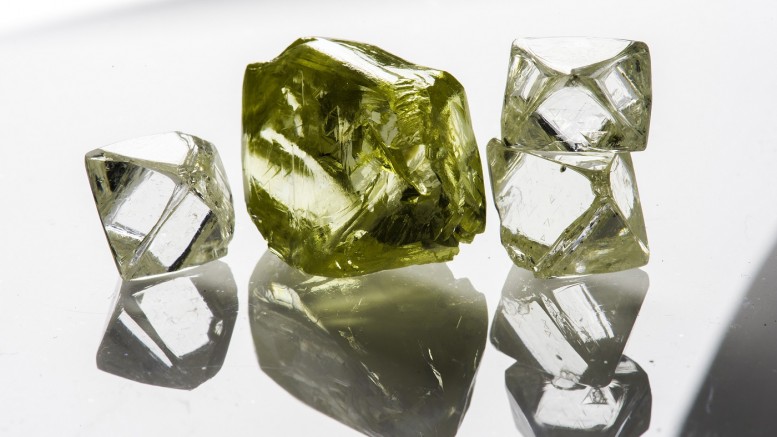With a dismal 2015 in the rear-view mirror, the first half of 2016 saw surprisingly strong demand for rough diamonds. However, with new production coming online from several mines in the next year, investors likely won’t be able to rely on buoyant rough diamond prices to fuel diamond miners’ share prices, says Des Kilalea, a mining analyst with RBC Capital Markets. In an interview with Diamonds in Canada in late September, Kilalea explained recent trends in the market, and what they’re likely to mean for rough diamond and equity prices in 2017 and beyond.
Diamonds in Canada: Can you summarize the current state of the diamond market and what’s happened over the last couple of years in terms of rough prices?
Des Kilalea: Last year was pretty bad. Rough prices were down at least 15% and in some cases, prices — particularly in some of the smaller goods — were down way more than that. The first half of this year saw a modest recovery, so we’re probably up a few per cent this year in rough, but there was a very big sales season where the miners, particularly De Beers and Alrosa (RTS: ALRS) sold lots and lots of diamonds in the first six months — more than they produced; they sold plenty from inventory.
So there’s quite sizeable rough and polished in the market right now and it remains to be seen how the market clears over the busy year-end jewelry sales period. It’s fairly balanced at the moment — a good jewelry sales period at the end of the year and then we’ll probably see reasonable diamond prices — not up, but reasonable diamond prices next year.
DiC: Where was that unexpected demand coming from in the first half of the year, and is it sustainable through the second half and into next year?
DK: The demand was a result of rough diamond buyers being very quiet in late 2015 because of tight liquidity and excess polished inventory. As they sold the polished, they needed to replace inventory and this led to increased demand for rough.
For the demand to continue, there will need to be a sound jewelry sales season at year end — from Diwali to Christmas, Chinese New Year and Valentine’s Day.
DiC: When do you see the potential for rough prices to start to pick up?
DK: Not for some time because we’ve got Gahcho Kué and Renard coming onstream this year, as well as (Firestone Diamonds’ [LSE: FDI]) Liquobong in Lesotho, extra production from Petra Diamonds (LSE: PDL) and other small production. I think the scope for roughprice increases over the next three to four years is limited unless retail demand picks up strongly.
DiC: In this environment with all this new production coming online, which producers are likely to fare the best?
DK: Well, the new producers are in reasonably good shape because they’re fully funded. Stornoway Diamond (TSX: SWY), Mountain Province Diamonds (TSX: MPV) and Firestone have projects coming on — it’s not the best time to bring on projects given that there’s a lot of rough around, but there’s no financial pressure on them. They’ve got some debt to pay back, but no great financial pressure and their margins still look pretty good.
Anybody starting out on projects right now — that’s much more difficult. Dominion Diamond’s (TSX: DDC; NYSE: DDC) starting on projects — it’s got a good balance sheet, but it’s got a lot of money still to spend at a time when diamond prices won’t help as much as they might have a few years back.
Most of them are in a reasonably OK position provided De Beers and the Russians are restrained in their sales, which they have been. And that’s probably important — De Beers and the Russians have been very accommodating to the market, and so they should because they’re the ones who’ll lose the most if prices are very weak. So it’s a positive that the big guys have shown an inclination to be careful about how they supply the market.
DiC: You mentioned in a recent research note that most of the new supply coming on is coming from price-takers: unlike De Beers and Alrosa, they’re not going to hold back supply if the demand isn’t there.
Stornoway has made it clear that his company’s focus is going to be on the mining side — controlling mining costs and things like that rather than marketing. Is that a good call for the smaller guys?
DK: The new miners don’t intend to hold goods back from the market; they will sell production. They are in quite a comfortable position because individually they aren’t going to move the market. Renard will be producing +1.5 million carats a year and Gahcho Kué rather more, but even so, that’s compared to global production of 130 million carats. They’re not in a position that if they withheld production it would really change the market. So they’re right, they’ve got to sell everything they can. They’ll be price takers and they’ve accepted that and they’ll make sure that their costs are in such a state that they will be able to make money throughout.
DiC: You’ve got an outperform rating on Stornoway Diamond, which is bringing its Renard mine in Quebec online. Can you tell me what the value proposition is there?
DK: It’s a new project, it probably has a large-diamond distribution, which we’ll need to see. It is relatively attractive in relation to its underlying value, and it’s well managed. So that’s why we like it and similarly for Petra, which we also have an outperform rating on. We also like the project of Mountain Province very much — we think Gahcho Kué is a great mine and will see life beyond what is being projected at the moment.
DiC: When I spoke with Matt Manson, the CEO of Stornoway recently, he mentioned that the margins on diamond projects are quite high compared to metals projects generally.
DK: Correct. In general, many of the most profitable mines in the world are diamond mines such as Jwaneng, Karowe, Orapa and the new Canadian mines.
I’m more negative on diamond prices than most people in the near term because of the new production coming onstream and demand being slightly less robust than we would have thought a few years ago because China’s not growing as much as expected. But post-2020, there’s very little new production coming onstream and there’s a list of mines which are likely to close down (Argyle, Ekati ex Jay, Victor, etc). There will be Jay, but Jay’s only replacement production for Ekati, it’s not new. So the outlook post-2020 looks pretty good.
DiC: Lucara Diamond (TSX: LUC) has produced some exceptional diamonds but their most impressive diamond, the 1,109-carat Lesedi La Rona failed to sell this year. They are now putting in a Mega-diamond recovery circuit at their Karowe mine to recover more stones bigger than 1,000 carats. How big is the market for such large stones and do they risk oversupplying it?
DK: The 1,109-carat diamond did not “fail to sell.” Lucara decided not to accept the effective $68-million bid because it believes it will get more for the stone. While the bid was $61 million, Lucara would also have received the 12% buyer’s commission, I believe.
The market for these mega stones is not large and that is why Lucara looked into a different selling method. Lucara can afford to be selective in the way it sells such diamonds because its run-of-mine production is so profitable and cash generating. Lucara has just announced a second exceptional stone tender; the one in April fetched $51 million, and it appears demand for these stones has been resilient.
DiC: You noted recently that there’s an ongoing issue with liquidity in the mid-stream (which is basically everyone in the middle of the diamond pipeline in between the miners and the retailers). Is there another potential source of liquidity that could relieve this pressure on the mid-stream?
DK: Not in any quantity. The key is that the mid-stream has got to slim down. There’s just been too much in the mid-stream — too much debt, too much inventory and it was unhealthy. In a way, it created some of the issues we’re seeing now. There was too much polished for a reason and that’s because the guys in the mid-stream had debt. It’s better that the mid-stream becomes more rational: We need less working capital in the mid-stream, not more.
DiC: This sounds like it’s going to be a long process.
DK: Yes, but a healthy one. We’ll see businesses leave the industry, leave the mid-stream, businesses that don’t have the economics to survive. If we have this discussion in three years or so, we’ll probably say an awful lot of companies have left the mid-stream and now the mid-stream’s in much better shape.
DiC: What are your thoughts on the Diamonds Producers Association? They’ve just got it started officially this year.
DK: It’s early days, but it’s essential; it’s way overdue. The real question is does it have a big enough budget. If it wants to create awareness of diamonds as a product and compete with products like man-made diamonds and other luxuries, then I suspect the budget’s not big enough. And then it’s going to be the question about how you get the big producers in particular to put their hands in their pockets to increase the budget. I think the budget will end up being too small. But it’s essential that they do something.
DiC: Demand for diamonds in the U.S. is still pretty strong, but what about in China and India?
DK: India’s biggest problem is currency. The trouble is when the rupee goes down and the dollar goes up, that’s not good for diamond sales. China’s alright — it’s going very sluggishly. A lot of big stores have cut back their expansion programs over recent years. It’s not so much the corruption issues because that doesn’t really affect everyday diamond jewelry, but it does affect consumer confidence. So that’s the problem really is getting consumers more confident and also persuading them that they need diamonds. Now I think China’s going to be an easier market than India for the DPA to succeed in. The U.S. (market) has got a life of its own really, but India is a challenge.
— This story was originally published in the November issue of Diamonds in Canada.





Be the first to comment on "Q&A: Decoding the diamond market"